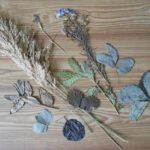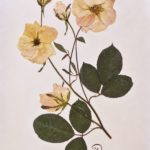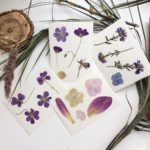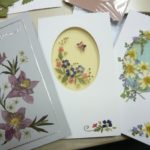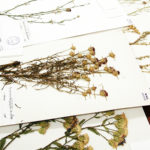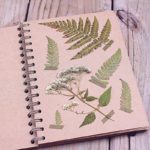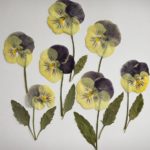Rules for collecting, drying and decorating a herbarium
Original twigs of plants, unique flowers, bright foxes from trees - sometimes even adults want to preserve such beauty for a long time. Very often, the question of how to make a herbarium is asked to children in kindergarten or students at school. Detailed information is provided below about all the technical features of collecting various plants for herbarium, proper drying, competent compilation and long-term storage of the herbarium. Bright photos will complement the instruction.

- What is a herbarium and what does it look like
- Why is it so important to involve children in collecting herbariums?
- How to collect samples for a herbarium
- How to dry harvested plants
- How to make a herbarium correctly
- The easiest version of a herbarium for school or kindergarten
- Herbarium in the interior
- VIDEO: How to properly prepare flowers for a herbarium.
- 50 DIY herbarium design options:
What is a herbarium and what does it look like
The word "herbarium" is of Latin origin and in translation means "grass". The modern world has two different interpretations-designations for the herbarium:
- A way to preserve (in order to later consider and present for viewing to others) the natural beauty of living plants outside their seasonal development period and the territory of distribution of each individual species. The traditional way to create herbariums is to routinely dry plucked plants, leaves or flowers that have been harvested.
- According to the second definition (more scientific), the word "herbarium" is a special center (house) where you can view entire collections of unique (possibly even disappeared from our land) flora representatives. Here are presented plant compositions from different parts of the world. Each species is stored in special temperature and climatic conditions, strictly under glass and is available only for contemplation (touching with your hands is prohibited!).

Very often, collections of plant herbariums collected at different latitudes of the planet Earth are supplemented with an entomological collection of insects that live in a given area. Such dried sets are also called insect herbariums.

The purpose of the herbarium is that thanks to a special method of drying plants + insects and storing these exhibits, a person gets a unique opportunity to contemplate in natural form and at any time all the richness of the natural world. Such collections are especially valuable in order to get an idea of already extinct plants in real form.

Why is it so important to involve children in collecting herbariums?
In the school curriculum for such general subjects as biology, natural science, natural history, the topic of herbarium is necessarily included. As a homework assignment, the teacher often assigns students the task of assembling a herbarium, making interesting crafts from a herbarium made up of plants from their area or any specific plants.

To do this work correctly, you need to study the following points in detail:
- how to collect a herbarium,
- what are the features of the subsequent design of such a collection,
- how you can creatively modify the collection,
- how to preserve your herbarium for a long time so that the memory from childhood remains.

The answers to all of the above questions are described below.
How to collect samples for a herbarium
The answer to the questions: how and when to collect samples for the herbarium depends on the goal set by the teacher. For example, collect a herbarium of early spring primroses that grow in your area. A prerequisite for collecting such plants is a clear sunny day and a walk in the adjacent forest park area.

ATTENTION! Do not let your child go alone or even in a company with peers. Regardless of the season of the year, there are enough poisonous plants, snakes, insects in nature, which are dangerous to touch with your hands. The control and protection of an adult from such troubles is necessary!
Take with you:
- An improvised tool (a small shovel for digging up a plant with a root and dry paper napkins to remove excess moisture from the leaves, and unnecessary clods of earth from the roots);
- A thick book, between the sheets of which it is convenient to lay plucked plants;
- A container with water to wash your hands afterwards, and a towel.

ADVICE! You need to choose plants with the least amount of external damage, with clean leaves and beautifully loose flowers.
Algorithm for collecting plants for herbarium:
- Choose an even plant that is not damaged by insects and fungal diseases in the flowering phase;
- In order to be able to imagine, to see all the plant elements of a particular species, you should carefully dig out the root of the plant and lightly shake off the earth from it;
- Then unfold a paper napkin, put the plant on one half and cover with the other half of the napkin, press lightly for a couple of seconds - all excess moisture and dirt will be absorbed into the paper;
- Now you can put the plant between the book sheets to keep the plant's shape practically unchanged.

RECOMMENDATIONS! Under the press of book pages, the dried herbarium turns out to be almost flat. If it is necessary to preserve the bulk of the plant, then it must be dried in a dark, dry, but cool (not higher than + 15 C) place.

How to dry harvested plants
Why a thick book is considered the best way to dry plants for a herbarium is not difficult to understand.
Firstly, between the sheets of the book, the temperature is almost optimal for high-quality drying of plant elements (leaves, flowers, roots).

Secondly, the plant placed in the book will never get sunlight.
ATTENTION! If sunlight falls on it during home drying of a plant, then the color of the leaves, stem and flower changes dramatically. It just burns out in the sun, turns yellow-brown, and the shape of the plant shrivels, as if from a furnace! It is clear that albums or pictures cannot be formed from such burnt plants.

Time for high-quality drying of the herbarium is needed at least 2-3 weeks, so that the internal moisture from the leaves and stem is absorbed into the book sheets, keeping the color, shape and even the aroma of the plant unchanged. Depending on the juiciness of the selected plant, more time may be needed.

For example, fallen leaves dry in a matter of days, because they have already lost most of their internal fluid. But a plant like a rose, which must be dried in a standing upright position (in a vase) and in a dark, dry, cool place, will dry for a herbarium in more than a month.

How to make a herbarium correctly
So, the plant flower arrangement was collected, dried with high quality - now how to make the herbarium correctly and beautifully? The pictures and photos of herbariums presented below will help you to fantasize!
There are plenty of ways to draw up a herbarium. The easiest and most affordable is to create an album from dried plants. Each plant must be carefully placed on a dense sheet of an album (you can glue it with ordinary PVA, or you can fix it with small strips of tape).

Below, under the plant, be sure to place a label with the inscription:
- plant names (preferably in Russian and Latin),
- collection time (day / month / year),
- the place of collection is as specific as possible.
After such a design, even after tens of years, having opened an album for a herbarium, a person will be able to find out all the necessary information.

The second way is to make paintings from the herbarium. This is a more complex process that requires more time and tools:
- First of all, prepare the canvas for the future painting. It should be a dense fabric (burlap, etc.).
- Now you need to think about the picture frame. And the available natural material (wooden bars, even twigs, or twigs woven into a braid) - there are plenty of options.
- After the base of the picture is ready, you can start compiling the picture itself from the herbarium. What will be depicted is up to the artist. An ordinary scene from life, fairy tales, or maybe surreal episodes, abstraction - you can non-stop fantasizing from natural material. Moreover, it is quite acceptable to draw something, decorate, add creative design elements, etc.

The easiest version of a herbarium for school or kindergarten
It is easy to make a herbarium for a child in a kindergarten or a first grader for school if you look through and be inspired by various templates on thematic sites in the internet. The easiest way is to collect the bright yellow-red leaves of the Queen of Autumn, dry them in a book and make an interesting fabulous composition of them on an album sheet (stick to the surface).

From leaves, twigs, flowers, you can easily form animal figures (hedgehogs, hares, foxes, cats, etc.), make little men (girls in dresses and headscarves and boys), and also recreate elements of the territory, games, and everyday life. You just need a desire, a little creative inspiration and, of course, time for the herbarium craft to turn out to be great.

Herbarium in the interior
They came up with numerous ways to decorate the interior of the house with the help of herbarium compositions. So, bright crafts from the herbarium will take their rightful place in the children's room, bedroom, kitchen, hallway. If you place such a picture in the bedroom, you can supplement the herbarium exposition, for example, with medicinal aromatic herbs (mint, lemon balm, rosemary, etc.). We get a double effect: beauty and original design + soothing and other therapeutic and prophylactic effect.

THE MOST IMPORTANT! In any case, to collect and decorate with your baby a herbarium, which later hang on the wall or put on the table in the form of a picture, means to preserve for a long memory cheerful good moments of communication, creative fantasies, spent time together.
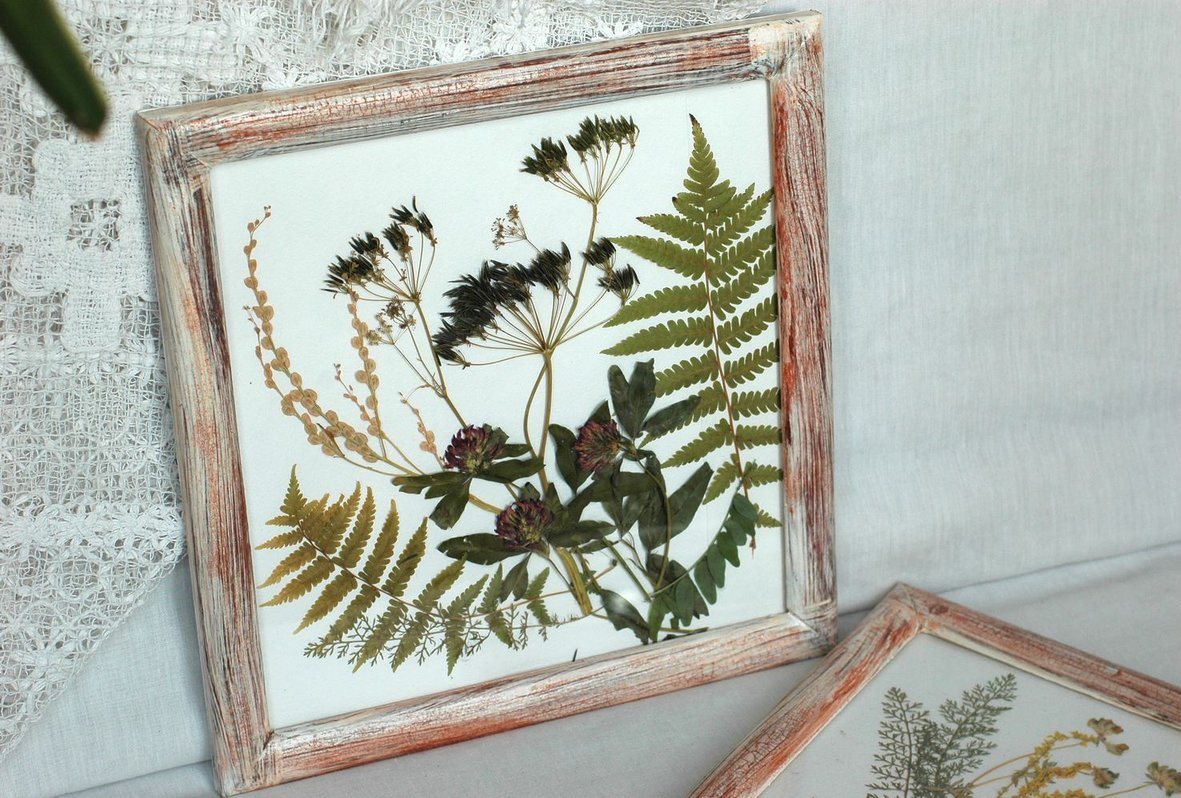
VIDEO: How to properly prepare flowers for a herbarium.

